Ever wondered how kombucha – the deliciously fizzy fermented tea – is made? We’re breaking down the basics of how to make kombucha, from start to finish! No fancy equipment or ingredients needed.
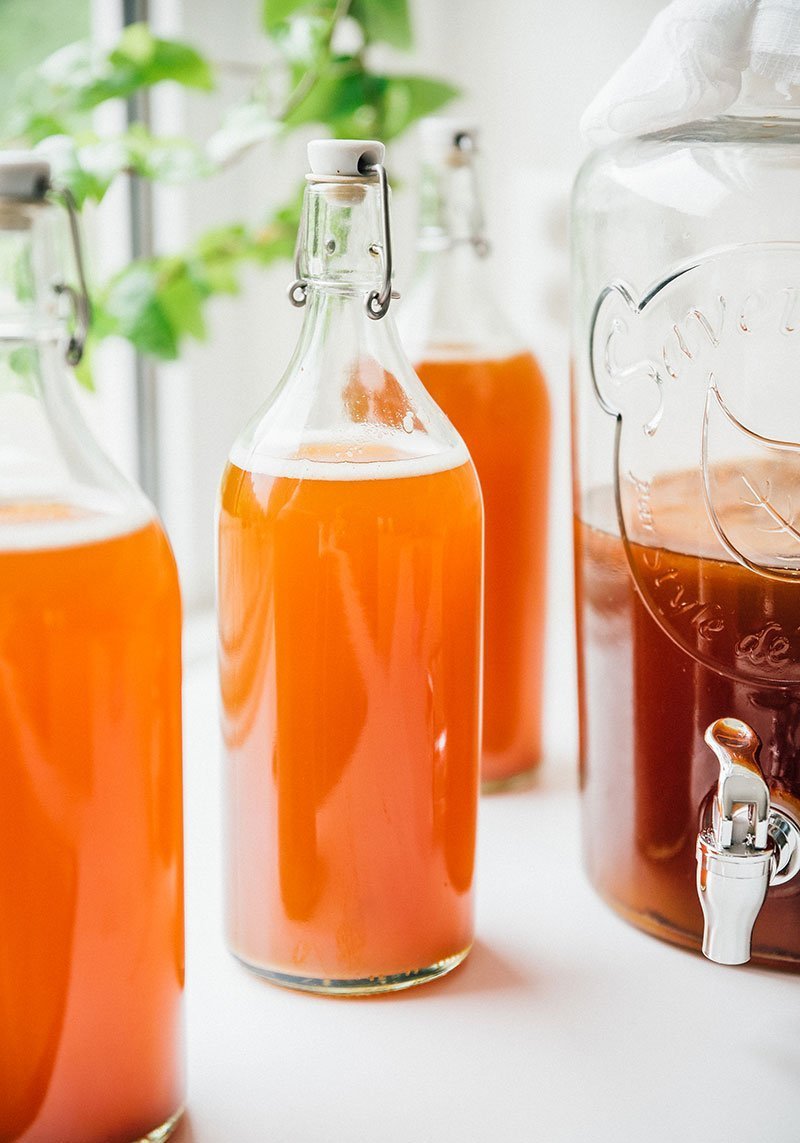
Curious how to make kombucha, the gut-loving healthy fermented tea? Tired of paying $5 per bottle when you could be making it at home for a fraction of the price? Let’s brew!
Making homemade kombucha has three main steps (click the links below to jump around the post):
- Make SCOBY (1 to 4 weeks) – make the “mother”
- First Fermentation (6 to 10 days) – make the actual kombucha tea
- Second Fermentation (3 to 10 days) – carbonate the kombucha tea
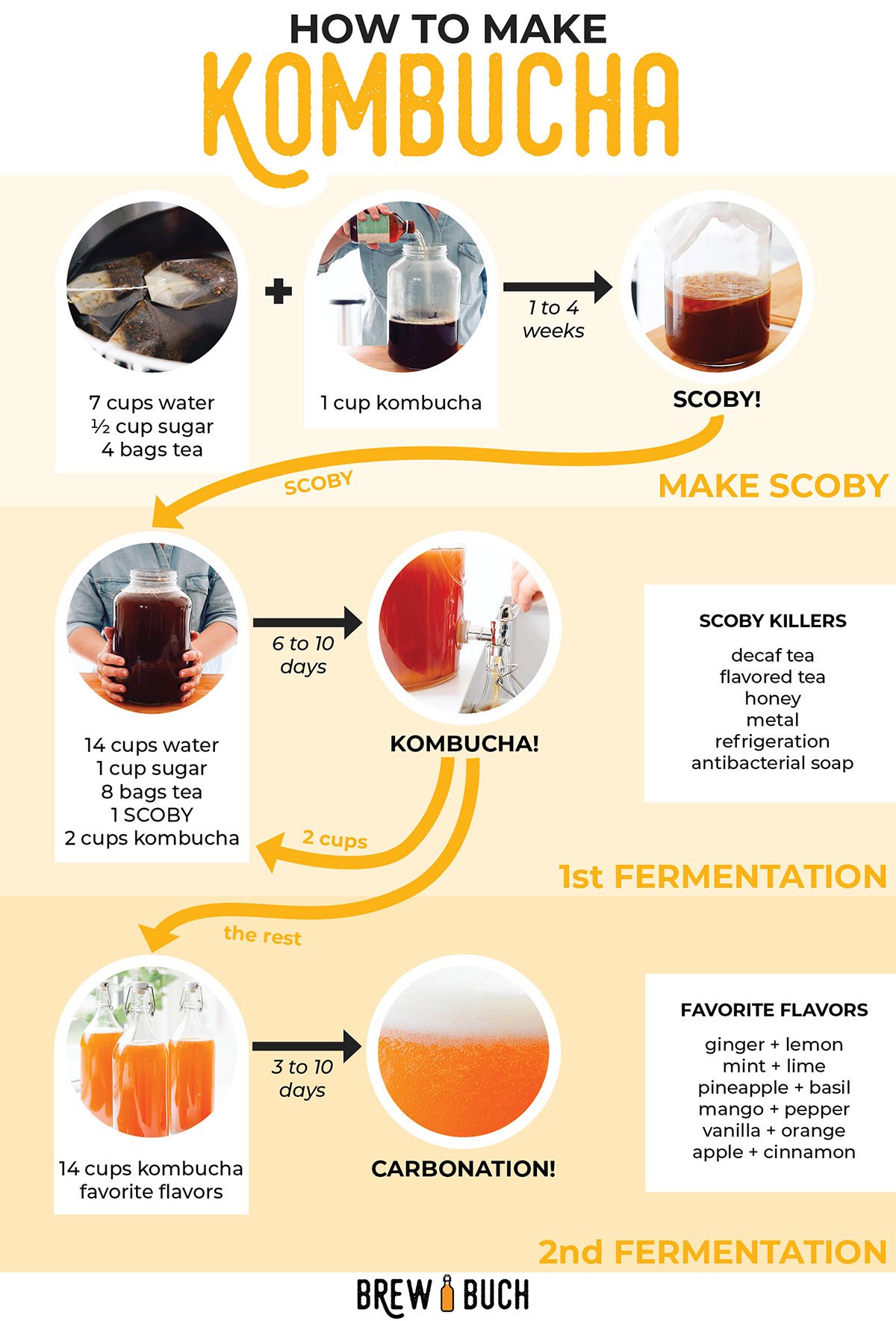
This post contains affiliate links, and I may earn from qualifying purchases.

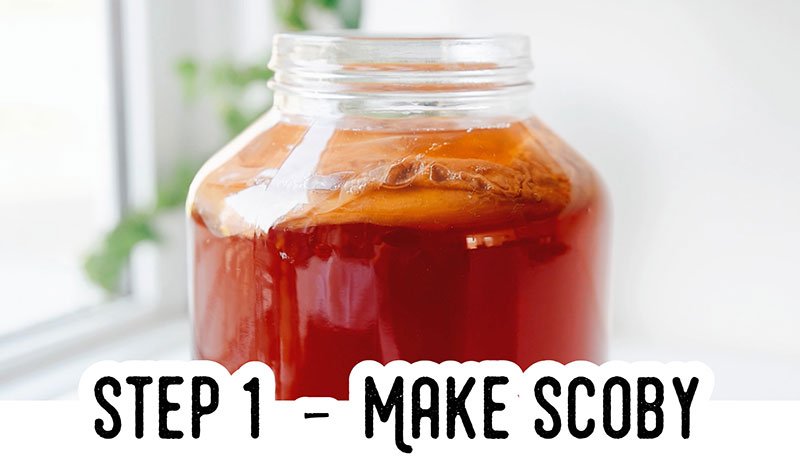
How to make a kombucha SCOBY
The SCOBY (Symbiotic Culture Of Bacteria and Yeast) is a pellicle that forms on top of the brew. The SCOBY is the “mother” that kickstarts each batch while also protecting the kombucha from contaminants like dust and debris. While you can buy a ready-made SCOBY (online or even on Craigslist), it’s easy to make it yourself!
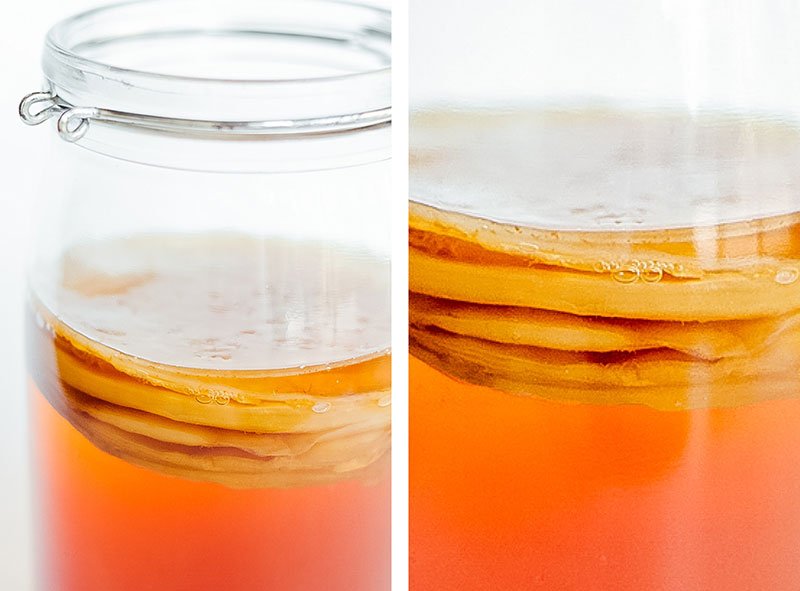
Ingredients to make a SCOBY
- 7 cups (1.6 L) water (tap water should be fine)
- ½ cup (100 g) white sugar (sugars you can use in kombucha)
- 4 bags black tea (teas you can use in kombucha)
- 1 cup (240 mL) unpasteurized, unflavored store bought kombucha
Supplies needed to make a SCOBY
- A large glass or ceramic container (should hold at least 1 gallon (3.7 L))
- Tightly woven cloth (coffee filters, paper towels, napkins, cheese cloth)
- Rubberbands
- Large pot for boiling water
How to make a SCOBY
1. Make Sweet Tea: Bring water to a boil. Remove from heat and dissolve sugar into it. Add the tea bags and allow them to steep for at least 20 minutes (or until tea has cooled).
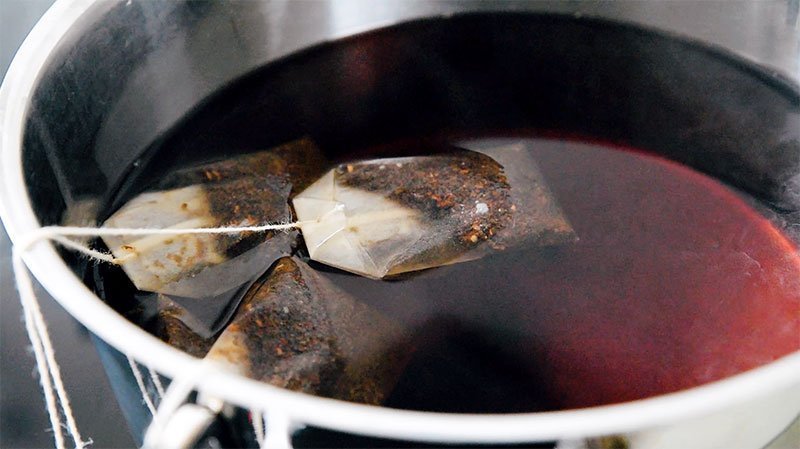
2. Cool to Room Temp: Allow hot tea to cool to room temperature. Quicken this process by boiling just 2 cups of water, dissolving the sugar, and steeping the tea for 20 minutes. Then add remaining 5 cups of cold water, which will bring the mixture to room temperature faster. Test that the tea is room temperature by drawing out some tea with a paper straw, using your finger to keep the kombucha in the straw.
3. Add Starter: Pour the sweetened tea into your jar, then pour store-bought kombucha in, making sure to include any gunkies that may be at the bottom of the kombucha bottle. These are great for kickstarting the fermentation!
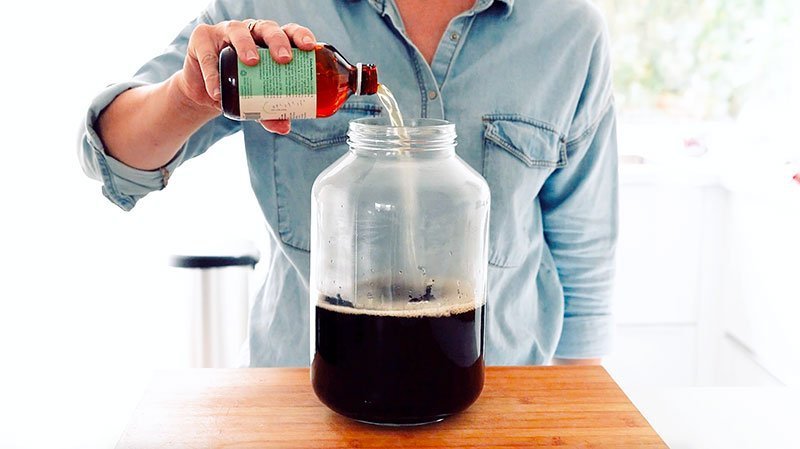
4. Cover: Cover with a few layers of the tightly woven cloth to keep out bugs and debris, securing with a rubber band.
5. Ferment: Set somewhere dark, still, and room temperature (70-75 degrees F, 21-24 C) for 1 to 4 weeks, until a ¼ inch (½ cm) SCOBY has formed.
6. Go to 1st Fermentation: You now have a SCOBY! The SCOBY should live and grow for years if treated with love. Allow the SCOBY to remain in this liquid until you are ready to use the SCOBY for the next step, the 1st fermentation.
Things to note when making your kombucha SCOBY
- No decaf: The SCOBY doesn’t like decaf tea and will not grow as well if fed it.
- Only black tea: The SCOBY doesn’t grow well with green or fruity teas. Once your SCOBY is larger you can use green tea, but for now stick with black.
- No honey: Honey can contain botulism bacteria that, when grown exponentially as bacteria and yeast tend to do in kombucha, can be dangerous. You can use honey in the second fermentation, once there are a higher number of good bacteria to fight off the bad, but for now, stick to sugar.

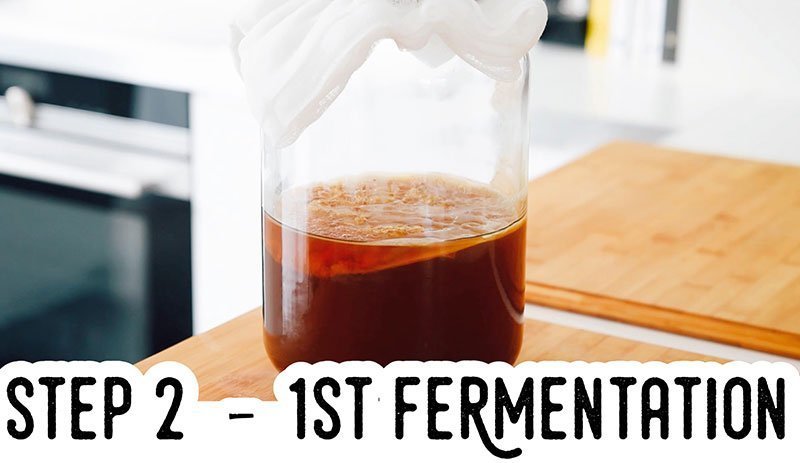
The First Fermentation
So you’ve got a SCOBY and you’re ready to get this komboo-choo train rollin’. The first fermentation is where you actually make the kombucha that you’ll be drinking!
Ingredients for the first fermentation
- 14 cups (3.3 L) water (tap water should be fine)
- 1 cup (200 g) white sugar
- 8 bags black or green tea
- 2 cups (480 mL) unflavored kombucha (either from a previous batch or unpasteurized, unflavored store bought kombucha)
- 1 SCOBY
Supplies for the first fermentation
- A large glass or ceramic container (should hold at least 1 gallon (3.7 L))
- Tightly woven cloth (coffee filters, paper towels, napkins, cheese cloth)
- Rubberbands
- Large pot for boiling water
First fermentation instructions
1. Make Sweet Tea: Bring water to a boil. Remove from heat and dissolve sugar into it. Add the tea bags and allow them to steep for at least 20 minutes (or until tea has cooled).
2. Cool to Room Temp: Allow hot tea to cool to room temperature. Quicken this process by boiling just 4 cups of water, dissolving the sugar, and steeping the tea for 20 minutes. Then add remaining 10 cups of cold water, which will bring the mixture to room temperature faster. Test that the tea is room temperature by drawing out some tea with a paper straw, using your finger to keep the kombucha in the straw. (Don’t be impatient here – hot water will kill your SCOBY).
3. Empty the Jar: With very clean hands, transfer SCOBY to an equally clean plate. If this is your first round of kombucha, reserve 2 cups of the liquid the SCOBY was growing in (that can be your starter kombucha), discarding the rest of the liquid (it is very acidic and not nice for drinking).
4. Add Starter: Pour the sweetened tea into your jar, then pour in unflavored starter kombucha. With clean hands, place SCOBY into jar.
5. Cover: Cover with a few layers of the tightly woven cloth and secure with a rubber band.
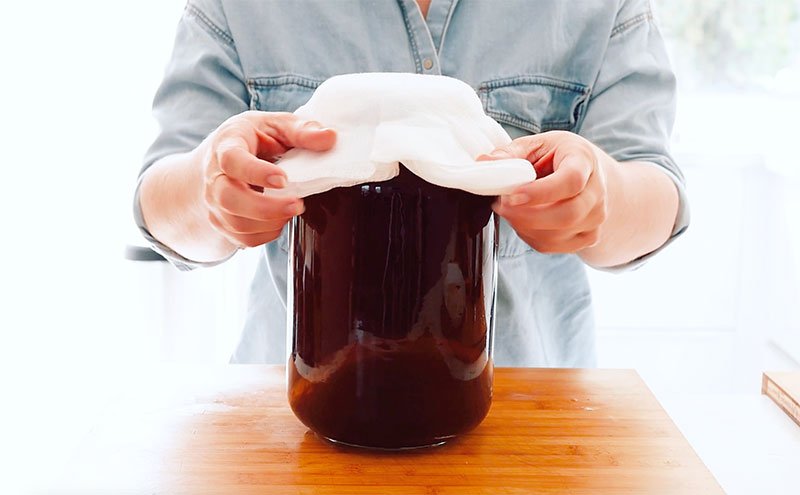
6. Ferment: Set the jar somewhere dark, still, and room temperature (70-75 degrees F, 21-24 C) for 6 to 10 days. Begin tasting at about 6 days by gently drawing out some of the tea with a paper straw (using your finger to hold the tea in the straw – don’t use your mouth). It should be mildly sweet and slightly vinegary. The warmer the air temperature, the faster the kombucha will ferment. The longer the tea ferments, the more sugar molecules will be eaten up, the less sweet it will be.
7. Go to 2nd Fermentation: Reserve 2 cups from this batch to use as starter kombucha for your next batch (just leave it in the jar with SCOBY). The rest can move into the second and final fermentation.
Things to note about the first fermentation
- Other teas can be used in this step! Feel free to experiment with green, white, oolong, or combinations of them. Fruit teas should be mixed with a few black tea bags to ensure the SCOBY gets what she needs to thrive.
- Big SCOBY? Once the SCOBY gets to be about an inch thick, peel off a few layers to create a second SCOBY (use it to create another batch or gift it to a friend!)

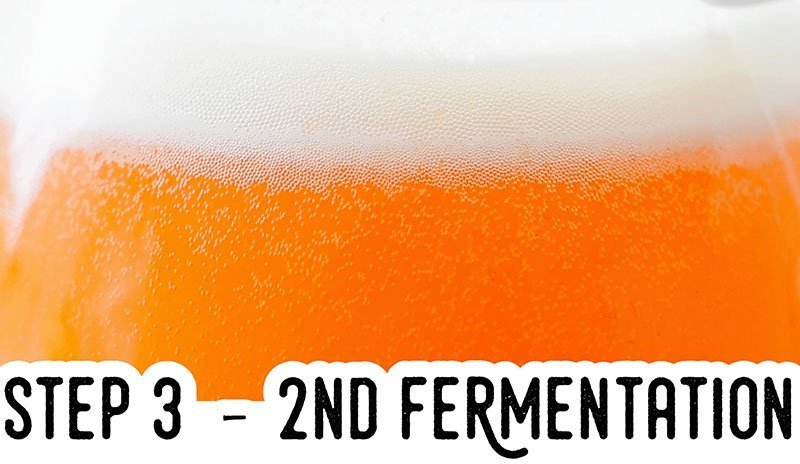
The second fermentation
The final and most fun step in the homemade kombucha making process! The second fermentation is where the real magic happens, flavoring and carbonating your kombucha into effervescent bliss.
Ingredients for the second fermentation
- Homemade kombucha from the first fermentation
- Sweetener (fruit, honey, or sugar). While there are many flavor combinations here on Brew Buch, we generally work with a ratio of 1 cup kombucha to:
- 1 to 2 Tbsp mashed fruit or fruit juice
- 1 to 2 tsp honey or sugar
Supplies for the second fermentation
You just need a few flip top fermentation bottles for the second fermentation. These bottles are meant for fermentation and have an airtight seal, which will prevent carbonation from escaping. If you don’t have these, canning jars will do an alright job, though they aren’t truly airtight.
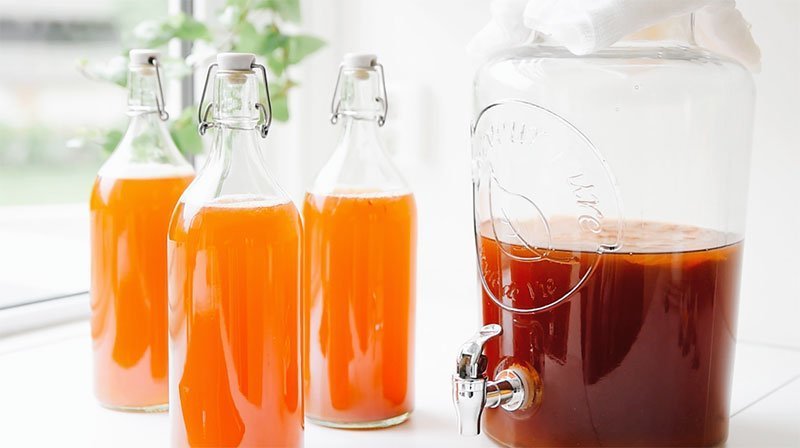
Second fermentation instructions
1. Bottle: Funnel kombucha into bottles, leaving about 1 1/2 inches at the top (3.8 cm).
2. Sweeten: Add your chosen sweetener and seal tightly.
3. Ferment: Let ferment somewhere dark and room temperature for 3 to 10 days.
4. Serve: If desired, strain out fruit before serving. Place in fridge to slow the carbonation process and to chill before serving.
Things to note about the second fermentation
- Blast Zone: Your jars can explode if the pressure becomes too high! For your first few batches while you’re still getting the hang of how kombucha reacts to your environment, bottle a portion of it in a plastic bottle. This will act as a gauge for the others; when the plastic bottle is rock solid, the rest are probably done. “Burp” them by opening each to release some pressure, then place them in the refrigerator to slow fermentation.
- Faster Fermentation: Be aware that the kombucha will ferment more quickly when it is warmer and when there is more sugar/fruit. It will ferment more slowly in the opposite conditions!
- No fizz? Check out our troubleshooting guide to flat kombucha here.

This guide to was originally published on our sister site, Live Eat Learn, as part of the Simple Guide to Kickass Kombucha!
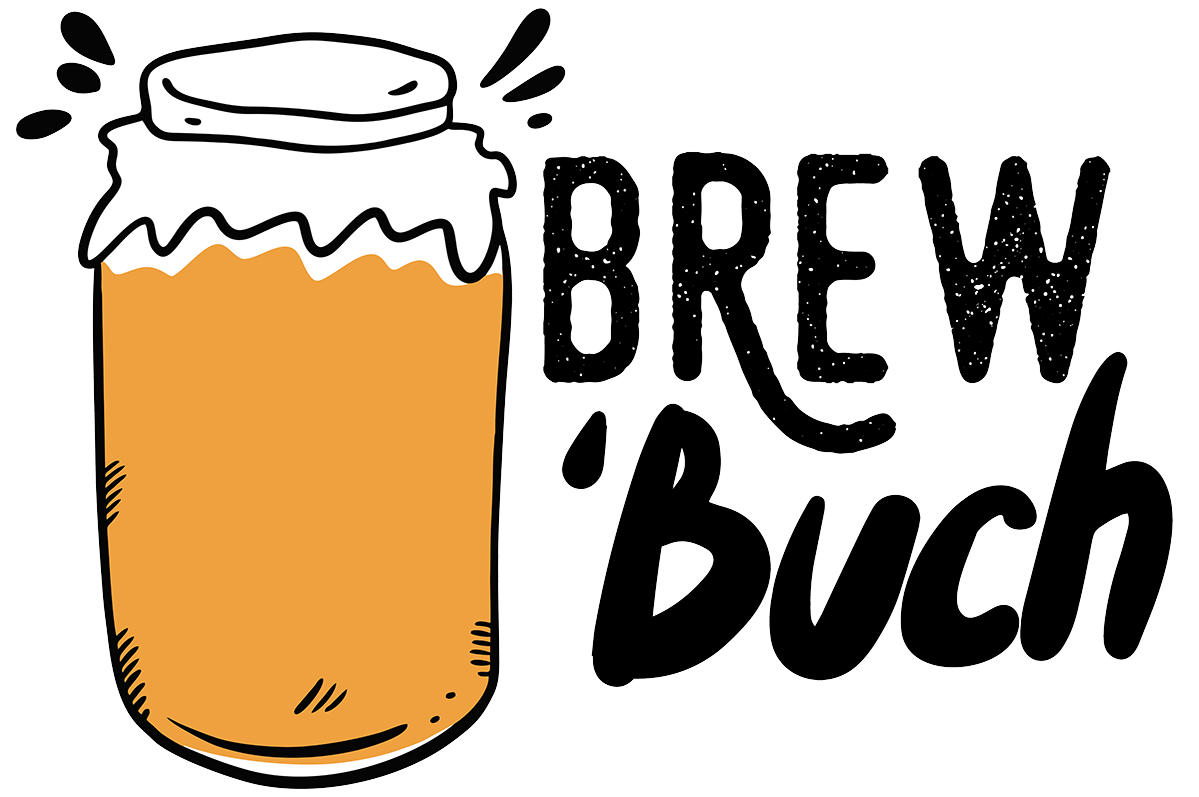
I was given a scobi by a friend and not quite enough starter liquid for a batch. I’ve tried finding the right kombucha in stores but haven’t had any success. Can I make a batch (smaller sized) without all of the starter liquid?
You really need starter to kickstart the reaction! I have info on where to find unflavored kombucha here 🙂
Hi Sarah! I just finished bottling for F2. I have a big SCOBY and a smaller one that developed in F1. I did end up using almost all the tea in the bottling process. What should I do with the SCOBYs now? I want to make sure they have enough “food” before I put them in the fridge for next time.
Thanks! Your site has been super helpful. I’m a newbie at this and I have a feeling they’re going to turn out delicious!!
Make a fresh batch of sweet tea and add it in! If you don’t have much started left, just scale back the amount of sweet tea you add.
Hi I am new to this a friend told me about kambocha, I tried to make it with no luck can you perhaps help me
This guide is a great place to start! It has everything you need to get going. Let me know if you have any specific questions!
Hi Sarah! I’m going away for 3 weeks and currently have a bunch of scobies (they keep multiplying lol). What is the best way to keep them while I’m away?
Thanks so much!
I’ve got a guide here with everything you need to know to take a break from brewing! 😀
The 1 to 2 tablespoons of mashed fruit and one to 2 tablespoons of sugar is that per gallon or 16 oz bottle. Sorry if this many be a silly questions but I’m very new to this.
For every 1 cup (8 oz) of kombucha you could do about 1 to 2 Tbsp mashed fruit or fruit juice OR 1 to 2 tsp honey or sugar (but it’s all to your taste, so feel free to adjust!)
Step 2 starts with placing the Scoby on an equally clean plate, and ends with placing the Scoby back in the jar. Can I remove the liquid without removing the Scoby, and pour the new room-temperature liquid back in to join Scoby? What’s the significance of taking the Scoby out and putting her back in?
You can do that! Both ways work 🙂
Hi! I followed your instructions on starting a scoby and it has turned out beautifully. Moving on to the first fermentation, is it okay if my scoby is submerged in the tea starter mixture, or does it have to be on the surface?
It’s okay if your SCOBY sinks or moves around in the jar, totally normal!
I’ve started my scoby a week ago and it’s starting to look great! How do I know when it is ready for first fermentation? Do I have to wait 4 weeks?
I usually start using it once it’s about 1/8 to 1/4 inch thick! 😀
I want to start making kombucha. What items do I need at a minimum to begin?
A big jar, big pot, and some bottles! Here’s everything you need with links.
Thank you so much for all this broken down information! I am one of those struggling to find unflavored kombucha I could just buy a SCOBY online but I really want to do this on my own, start to finish! <3 I have found Boostcha Vinegar with Black Tea Organic Kombucha do you think this could work as replacement for the initial cup of kombucha??
I think that could work! 😀
Would it be problematic, for the first fermentation, to make half the kombucha volume, i.e. 7 cups water, 1/2 cup sugar, 1 cup starter tea/unflavored kombucha, etc.?
That’s fine! You can scale the recipe up or down as much as needed.
Hi.
I put my scobys in the hotel for a while and now I’m ready to make another batch of kombucha. You mention something about using the tea from the hotel, but I’m not sure what for. Do you use that to make your next batch? Or do I just use the scoby and start all over with a new brew of tea?
Thanks!
The tea in the hotel can be used as the “starter tea” (aka the unflavored kombucha).
I used the incorrect email on my Previous message.
It was was with respect to my mistake in placing my first fermentation in the kitchen which is bright. I am wondering if it has spoilt because of this, since the Scooby has now fell and there is a white very very thin white layer on the top of the liquid.
That simply sounds like another SCOBY forming!
Thank you! Question: after the second fermentation, there was a film on top of the kombucha it was bubbly and kind of gray is that normal? I did have it in the dark for two days thank you
It sounds like just a baby SCOBY forming – totally normal! 😀
Hi, Sarah! I was wondering if it’s alright to stop on the first fermentation and consume it as is or is it really necessary to go through the second one? Thanks!
Yes you can totally stop at the first and not do the second fermentation! The second fermentation in brewing is really only for flavor and carbonation 😀
thanks for all the useful info on the do’s and don’ts with kombucha. the website is appealing, easy to navigate, and the FAQ is great for all the doubts one might have
we’ve just started to brew about a month ago, after a friend gave us a thick and slippery SCOBY, on improvised flasks we scavenged from around us, and i’ve found this resource really helpful
now that we’ve something going on and decided to upgrade our setup, with new purpose chosen and good quality flasks, i’ve returned to recheck the recipes for both fermentations, but am having a rough time translating tablespoons and cups to liters and millimeters for our new measurements
see, we’re in Europe and imperial units are weird and arcane rune-like glyphs to us. i’ve checked other resources (even on my native language), but measures and instructions change and since we’ve trusted you and everything is going smooth, i’ve stubbornly made the calculations base on your numbers
soooo, all this to make the suggestion of adding metric measurements to your recipes, so that this resource becomes perfect! it’s surely help other folks like me who stumble upon here and will surely help with your reach
again, a big thank you and good luck!
Hi Sarah,
Love your site! Easy to follow which is great as I am new to this kombucha brewing world and this gives me something to do during the long winters of Wyoming. That being said, I am at high altitude~7,000 ft. My first batch was amazingly delicious and fizzy.
My question has to do about timing for the last fermentation in the serving bottles. I was gone during the first batch for 6 weeks and it had already been bottled for 2 weeks. I was worried there would be an explosive mess upon returning! Luckily all went well and bottles intact.
My first tasting had me over the moon happy as I was so a bit aprehensive regarding the timing and carbonation/ flavor etc… Second batch is brewing now and wondering if you have any thoughts about timing for 1st and 2nd fermention at this altitude.
Thanks for your kind response.
Oh that’s a great question! I live in Denver, so also at altitude. I haven’t noticed a huge difference between brewing at altitude and brewing at sea level, usually just need a few extra days in F2 to build up carbonation 🙂
Hi there, ive been given a scoby that was at the first stage of fermentation and im about to follow your instructions to do the second stage. My question is, when i leave the scoby and the two cupfuls to start a new batch, do i have to do this straightaway? Can i store the scoby and two cupfuls so that i dont have to be constantly doing a first fementation or must i always keep the production line rolling to keep the scoby alive?
Thanks
You can start right away of wait a little while! I have a guide to taking a break from brewing here!
I added 2 cups of starter tea by mistake instead of 1 to make a Scoby. What should I do now?
That’s fine! More is honestly better, it prevents mold and kickstarts the reaction more quickly 😀
Thank you for your down to earth, practical site, giving the information to get started
Hi.
I have two questions:
I’m making my first batch of Kombucha. 6 days into the 2nd fermentation, I re-read your instructions and see that they’re supposed to be in the dark. Don’t know why I thought it would be different from the 1st fermentation!! It’s in the dark now, but have I ruined it? There’s no sign of carbonation.
Secondly, it sounds like it’s ok to release air during this stage. Is this a way to check for carbonation or just a way to make sure it doesn’t over-carbonate?
Thanks!
It should be fine! Darkness is optimal but light won’t kill it right away. And yep, feel free to open it to check carbonation 😀